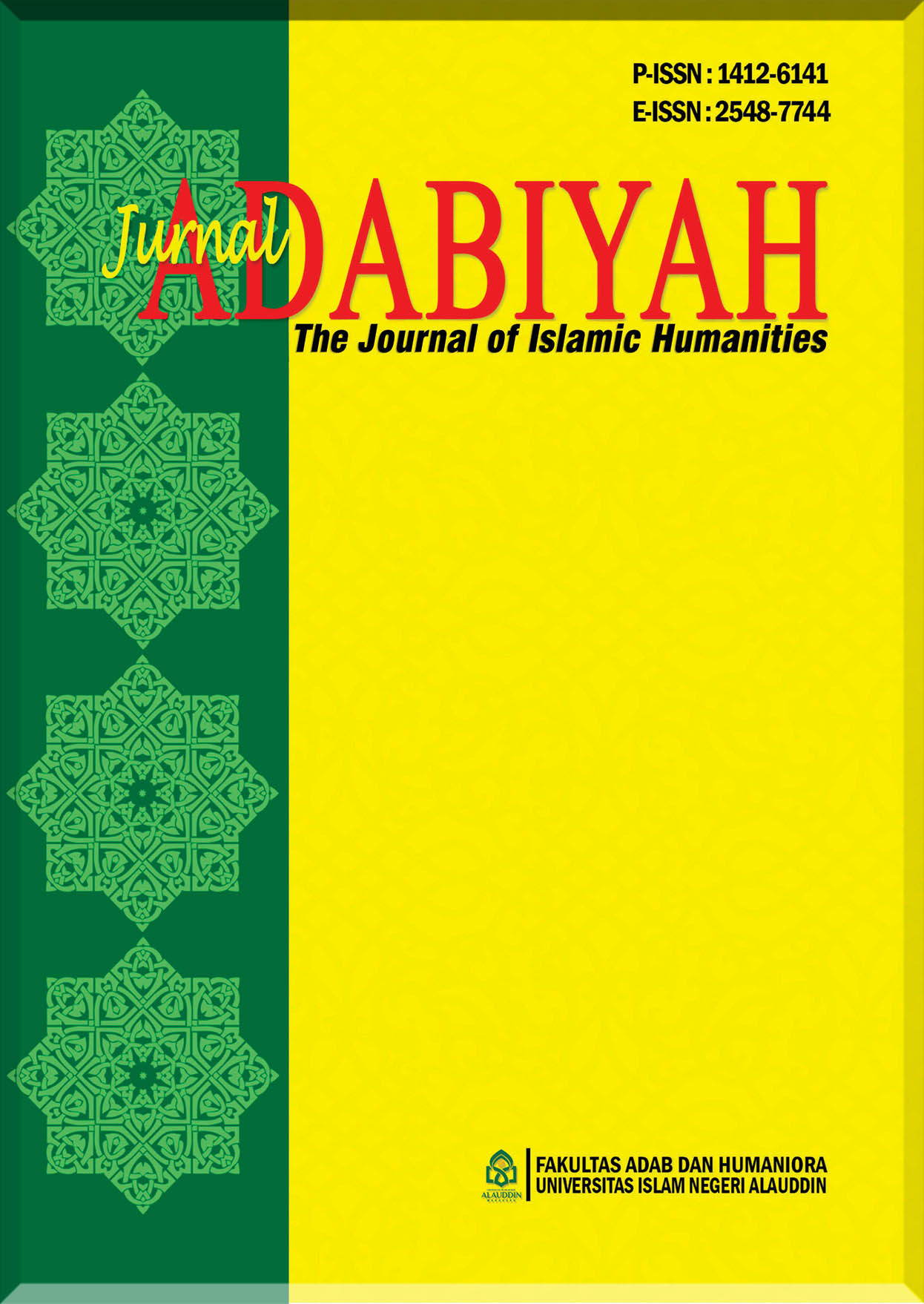Discursive Islam and Maritime Tradition: The Islamization of the Maccera Tasi Ritual in Luwu, South Sulawesi
DOI:
https://doi.org/10.24252/jad.v25i2a5Keywords:
Islam, Local Culture, Ritual, Luwu CommunityAbstract
This research is intended to investigate the interaction between Islam and local culture as reflected in the process of acculturation displayed in the tradition of Maccera Tasi. Using an anthropological approach, this research identifies the meanings and functions of coastal community rituals as a cultural system representing maritime Islamic culture in Eastern Indonesia. Relying on Talal Asad’s theory of discursive Islam, this research argues that the interaction of Islam within maritime culture does not merely reflect a static relationship but rather demonstrates dynamic complexities. Coastal communities in Eastern Indonesia, on the one hand, cooperatively preserve local traditions as cultural identity, while on the other hand, some groups resist by abandoning established traditions. By employing a qualitative method with data collection techniques such as in-depth interviews, documentation, archives, and digital sources, this research finds that the Maccera Tasi tradition reflects the adaptation of Islam within historical and cultural frameworks through various manifestations, such as the reinforcement of Islamic principles, the adoption of the adhan in four directions as the opening of the ritual, the transformation of the buffalo head offering into fish feed, and the practice of monotheistic prayers for safety. These findings broaden the understanding of the interaction between Islam and maritime culture, affirming that Islamic values are not only transformed but also embodied contextually within the symbolic, social and ecological spheres of coastal communities. This research provides an important contribution to understanding the dynamics of Islamic acculturation in the maritime regions of Southeast Asia.
الملخص
تهدف هذه الدراسة إلى دراسة التفاعل بين الإسلام والثقافة المحلية كما تتجلى في عملية التثاقف التي تتجلى في تراث ماشيرا تاسي. وباستخدام نهج أنثروبولوجي، تُحدد هذه الدراسة معنى ووظيفة طقوس المجتمعات الساحلية كنظام ثقافي يُمثل الثقافة الإسلامية البحرية في شرق إندونيسيا. واستنادًا إلى نظرية طلال أسد الخطابية الإسلامية، تُجادل هذه الدراسة بأن تفاعل الإسلام والثقافة البحرية لا يعكس علاقة ثابتة فحسب، بل يُظهر تعقيدًا ديناميكيًا. فمن جهة، تُحافظ المجتمعات الساحلية في شرق إندونيسيا بشكل تعاوني على التقاليد المحلية كهويات ثقافية، بينما تُقاومها بعض الجماعات بالتخلي عن التقاليد الراسخة. باستخدام الأساليب النوعية وتقنيات جمع البيانات مثل المقابلات المتعمقة والتوثيق والأرشيفات والمصادر الرقمية، تجد هذه الدراسة أن تقليد ماسيرا تاسي يعكس تكيف الإسلام في إطار تاريخي وثقافي من خلال مظاهر مختلفة، مثل تعزيز المبادئ الإسلامية، واستخدام الدعوة الرباعية للصلاة كبداية طقسية، وتحويل قرابين رأس الجاموس إلى طعام للأسماك، وممارسة الصلاة التوحيدية من أجل الخلاص .تُوسّع هذه النتائج فهمنا للتفاعل بين الإسلام والثقافة البحرية، مؤكدةً أن القيم الإسلامية لا تتحوّل فحسب، بل تتجسد أيضًا في سياقها في المجالات الرمزية والاجتماعية والبيئية للمجتمعات الساحلية. يُقدّم هذا البحث مساهمة مهمة في فهم ديناميكيات التثاقف الإسلامي في جنوب شرق آسيا البحري.
Abstrak
Penelitian ini bertujuan untuk mengkaji interaksi antara Islam dan budaya lokal sebagaimana tercermin dalam proses akulturasi yang ditampilkan dalam tradisi Maccera Tasi. Dengan pendekatan antropologis, penelitian ini mengidentifikasi makna dan fungsi ritual masyarakat pesisir sebagai sistem budaya yang merepresentasikan budaya Islam maritim di Indonesia Timur. Berdasarkan teori Islam diskursif Talal Asad, penelitian ini berargumen bahwa interaksi Islam dalam budaya maritim tidak sekadar mencerminkan hubungan yang statis, melainkan menunjukkan kompleksitas yang dinamis. Masyarakat pesisir di Indonesia Timur, di satu sisi, secara kooperatif melestarikan tradisi lokal sebagai identitas budaya, sementara di sisi lain, beberapa kelompok melakukan perlawanan dengan meninggalkan tradisi yang telah mapan. Dengan menggunakan metode kualitatif dan teknik pengumpulan data seperti wawancara mendalam, dokumentasi, arsip, dan sumber digital, penelitian ini menemukan bahwa tradisi Maccera Tasi mencerminkan adaptasi Islam dalam kerangka sejarah dan budaya melalui berbagai manifestasinya, seperti penguatan prinsip-prinsip Islam, penggunaan azan empat arah sebagai pembuka ritual, transformasi sesaji kepala kerbau menjadi pakan ikan, dan praktik doa tauhid untuk keselamatan. Temuan-temuan ini memperluas pemahaman tentang interaksi antara Islam dan budaya maritim, menegaskan bahwa nilai-nilai Islam tidak hanya ditransformasikan tetapi juga diwujudkan secara kontekstual dalam ranah simbolik, sosial dan ekologis masyarakat pesisir. Penelitian ini memberikan kontribusi penting untuk memahami dinamika akulturasi Islam di kawasan maritim Asia Tenggara.
Downloads
References
Abbas, Abbas. “Mistisisme Muslim Pesisir: Studi atas Ritual Masyarakat Muslim Bajo Sulawesi Tenggara.” Al-Izzah: Jurnal Hasil-Hasil Penelitian, Institut Agama Islam Negeri Kendari, 26 November 2022, 83. https://doi.org/10.31332/ai.v0i0.3731.
Abdullah, Anzar. “Islamisasi dI Sulawesi Selatan Dalam Persfektif Seharah.” Paramita: Historical Studies Journal 26, no. 1 (2016): 86. https://doi.org/10.15294/paramita.v26i1.5148.
Abdullah, Irwan. “Dari Bounded System ke Borderless Society: Krisis Metode Antropologi dalam Memahami Masyarakat Masa Kini.” Antropologi Indonesia 30, no. 2 (2014). https://doi.org/10.7454/ai.v30i2.3563.
Abu, Abdul Rahman, Hasriadi, Nurhady Sirimorok, Nirwan Ahmad Arsuka, Ade Pristie Wahyo, dan J. B. Kristanto. Manusia Bugis. Nalar [bekerjasama dengan] Forum Jakarta-Paris, Ecole francaise d’Extreme-Orient, 2006.
Adams, Kathleen M. Art as Politics: Re-Crafting Identities, Tourism, and Power in Tana Toraja, Indonesia. University of Hawaii Press, 2017. https://doi.org/10.1515/9780824861483.
Amir, Supratiwi. “Sulapa Eppa Pada Lipa Sabbe Sengkang.” Gelar : Jurnal Seni Budaya 16, no. 1 (2019). https://doi.org/10.33153/glr.v16i1.2339.
Ansaar, Ansaar. “Fungsi Dan Makna Ritual Maccera’binanga Di Kelurahan Bentenge Kabupaten Bulukumba.” Walasuji : Jurnal Sejarah dan Budaya 8, no. 2 (2017): 307–22. https://doi.org/10.36869/wjsb.v8i2.123.
Azka, Ibnu, Fathur Baldan Haramain, dan Mohammad Cholil Alwi. “Harmonization of Tradition and Islam: Mediating Culture and Religious Beliefs in Maccera Tasi Ritual in Luwu, South Sulawesi.” Heritage of Nusantara: International Journal of Religious Literature and Heritage 13, no. 1 (2024): 30–56. https://doi.org/10.31291/hn.v13i1.736.
Azka, Ibnu, Fathur Baldan Haramain, dan Mohammad Cholil Alwi. “Harmonization of Tradition and Islam: Mediating Culture and Religious Beliefs in Maccera Tasi Ritual in Luwu, South Sulawesi.” Heritage of Nusantara: International Journal of Religious Literature and Heritage 13, no. 1 (2024): 30–56. https://doi.org/10.31291/hn.v13i1.736.
Azra, Azyumardi. Islam nusantara, jaringan global dan lokal. Cet. 1. Mizan : Didistribusikan oleh Mizan Media Utama, 2002.
Azra, Azyumardi. Jaringan Ulama: Timur Tengah dan Kepulauan Nusantara Abad XVII & XVIII: Akar Pembaruan Islam Indonesia. Ed. rev. Kencana, 2004.
Downloads
Published
How to Cite
Issue
Section
License
Copyright (c) 2025 Al Mudzill, Hamdani

This work is licensed under a Creative Commons Attribution-NonCommercial-ShareAlike 4.0 International License.
COPYRIGHT AND LICENSE STATEMENT
COPYRIGHT
Jurnal Adabiyah is published under the terms of the Creative Commons Attribution license. Authors hold the copyright and retain publishing rights without restriction to their work. Users may read, download, copy, distribute, and print the work in any medium, provided the original work is properly cited.
LICENSE TO PUBLISH
1. License
The use of the article will be governed by the Creative Commons Attribution license as currently displayed on http://creativecommons.org/licenses/by/4.0.
2. Author’s Warranties
The author warrants that the article is original, written by stated author/s, has not been published before, contains no unlawful statements, does not infringe the rights of others, is subject to copyright that is vested exclusively in the author and free of any third party rights, and that any necessary written permissions to quote from other sources have been obtained by the author(s).
3. User Rights
Under the Creative Commons Attribution license, the users are free to download, reuse, reprint, modify, distribute and/or copy the content for any purpose, even commercially, as long as the original authors and source are cited. No permission is required from the authors or the publishers.
4. Co-Authorship
If the article was prepared jointly with other authors, the corresponding author warrants that he/she has been authorized by all co-authors, and agrees to inform his/her co-authors of the terms of this statement.
5. Miscellaneous
Jurnal Adabiyah may conform the article to a style of punctuation, spelling, capitalization, and usage that it deems appropriate. The author acknowledges that the article may be published so that it will be publicly accessible and such access will be free of charge for the readers.




